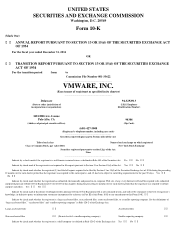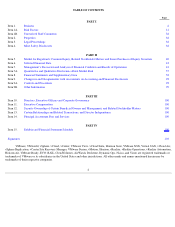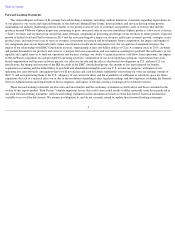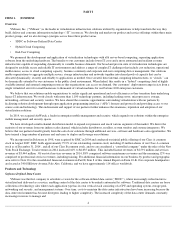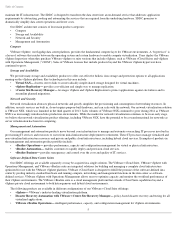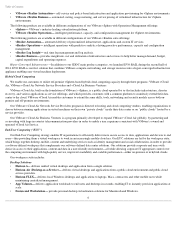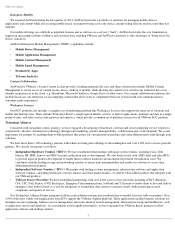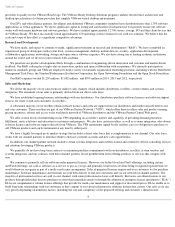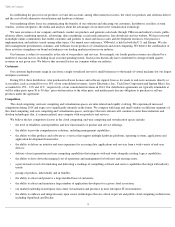VMware 2014 Annual Report Download - page 12
Download and view the complete annual report
Please find page 12 of the 2014 VMware annual report below. You can navigate through the pages in the report by either clicking on the pages listed below, or by using the keyword search tool below to find specific information within the annual report.
Table of Contents
Our vSphere-based data center virtualization product offerings are central to our SDDC product suites and remain essential to our business
strategy. Microsoft continues to be a primary competitor for data center virtualization solutions. We also compete with open source based
solutions based on the OpenStack platform as well as emerging container technologies like Docker and Rocket. Additionally, we compete with
Citrix and its collaborations with Microsoft for end-user computing solutions. With our entry into network virtualization we are experiencing
additional competition predominantly from Cisco.
Our management and automation product offerings that we market as part of our VMware vCloud Suites provide customers alternatives to
offerings from established IT management vendors, such as BMC, CA, HP and IBM, as well as many new entrants that are trying to penetrate
the nascent, higher growth cloud management markets.
During 2014, we expanded our hybrid cloud computing offerings and footprint, and rebranded our vCloud hybrid cloud services (“vCHS”)
to VMware vCloud Air. The cloud computing industry is dynamic with both established and new technology companies vying for thought
leadership and market share. With the launch of VMware vCloud Air, we now directly compete with infrastructure-as-a-service offerings from
Amazon, Microsoft, Google, IBM and emerging open source efforts. These cloud providers also present alternatives to VMware’s on-premises
data center footprint and compete against our hybrid cloud computing vision.
As we grow and increase the breadth of our product portfolio, we naturally encounter additional competition. Companies that are core
partners can become, over time, competitors. This cooperative competition is very common in the tech industry and is also known in the
common parlance as “coopetition.” This kind of competition can occur when we have alliances with vendors and partners that cover one part of
our business or geographical area, yet we compete with such partners in other businesses or other geographies or countries.
We actively work to segregate those parts of our business that compete with certain vendors or partners from those that partner with such
companies and employ the usual tools and protocols widely used by other firms to manage this potential conflict of interest, including the use of
confidentiality agreements and business function separation and segregation.
We are also competing with new entrants to the cloud computing, end-user computing and virtualization spaces, which may include parties
currently selling our products and our current technology partners. Existing and future competitors may introduce products in the same areas we
serve or intend to serve, and competing products may have better performance, lower prices, better functionality and broader acceptance than our
products. Our competitors may also add features to their cloud computing, end-user computing and virtualization products that are similar to
features that presently differentiate our product offerings from theirs. Additionally, some of our competitors may make acquisitions or enter into
partnerships or other strategic relationships with one another to offer more comprehensive solutions than those they individually had offered.
Some competitors have in the past, and may in the future, take advantage of their existing relationships with our business partners to engage in
business practices such as support, distribution and license restrictions that make our products less attractive to our channel partners and end
users.
Additionally, information technology companies are also increasingly seeking to deliver end-to-end IT solutions to end users that combine
enterprise-level hardware and software solutions in a converged infrastructure platform for private cloud computing. In addition, competitors
who have existing relationships with our current or prospective end users could integrate competitive capabilities into their existing products and
make them available without additional charge. Many of our current and potential competitors have longer operating histories, greater name
recognition, a larger customer base and significantly greater financial, technical, sales and marketing and other resources than we do. Overall
however, we believe our market position, large virtualization customer base, strong network of partners and indirect sales, broad and innovative
solutions suite, and platform-agnostic approach position us to compete effectively.
Intellectual Property
As of December 31, 2014, approximately 600 patents issued by the United States Patent and Trademark Office have been granted or
assigned to us. We also have been granted or assigned patents from other countries. These patents cover various aspects of our server
virtualization and other technologies. The granted United States patents will expire beginning in 2018, with the last patent expiring in 2033. We
also have numerous pending United States provisional and non-provisional patent
10
•
the ability to create and maintain partnering opportunities with hardware vendors, software vendors and cloud service providers;
• the ability to support newly emerging large-
scale application development and deployment approaches;
•
the ability to deploy operational cloud solutions for customers in a timely manner and provide robust technical support;
•
the ability to develop robust indirect sales channels; and
•
the ability to attract and retain cloud, virtualization and systems experts as key employees.


